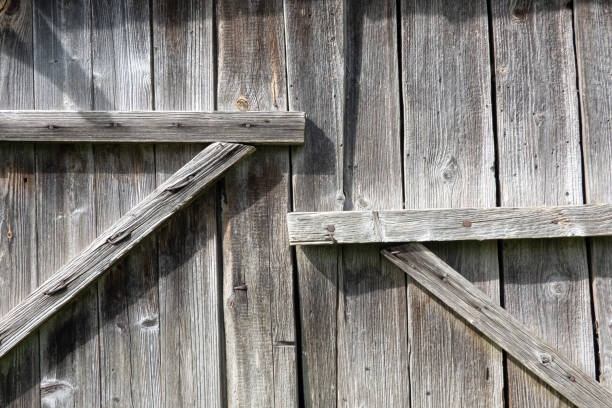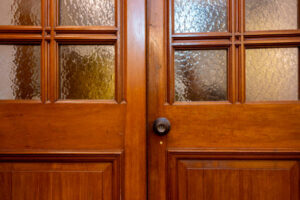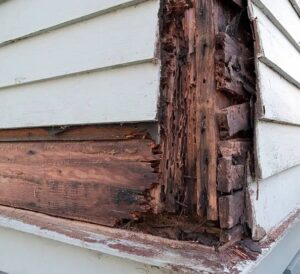
SYDNEY DECKING SOLUTIONS
Rotten Doors Fix: A Guide to Repairing Rotted Wood Doors and Door Frames

A beautiful timber door adds a touch of elegance and warmth to any home. But over time, exposure to the elements and moisture can lead to a dreaded enemy – rot. Rot is the deterioration of wood by microscopic organisms like fungi that feed on the wood fibres. Left untreated, rotten wood can spread, weakening the door’s structure and creating ugly holes. The good news is that, with a little know-how, you can often repair rotted wood in your doors yourself.
This guide will take you through the process of assessing the damage, gathering the tools required, and providing step-by-step instructions for repairing a rotted door.
Assessing the Damage: Is Your Door Rotten?

The first step is to identify and assess the extent of the rot on your door. Here are some signs to watch out for:
- Soft, spongy wood: Rotten wood will feel soft and crumbly when pressed with a screwdriver.
- Discoloration: Look for brown, black, or white patches on the wood’s surface, which can indicate different types of rot.
- Holes or cracks: Rot can cause the wood to become brittle and crack, leading to the formation of holes.
- Mould growth: Mould often thrives in damp, rotten environments.
If you notice any of these signs, it’s important to address the rot as soon as possible. Early intervention can prevent the rot from spreading and causing further damage.
Step-by-Step Guide to Repairing a Rotted Door
Tools Required:
- Safety glasses
- Dust mask
- Gloves
- Screwdriver
- Chisel
- Putty knife
- Sandpaper (various grits)
- Stiff brush
- Wood hardener (optional)
- High-bond filler (polyester filler or epoxy resin)
- Paint scraper (optional)
- Paintbrush (for applying filler)
Step 1: Prepare the Work Area
- Lay down a drop cloth to protect your work area from debris.
- Remove the door from its hinges if possible. This will give you better access to all the affected areas.
- Wear safety glasses, a dust mask, and gloves to protect yourself from dust and splinters.
Step 2: Assess and Remove Rotten Wood
- Use a screwdriver or chisel to carefully remove all the rotten wood. Work meticulously to avoid damaging the soundwood around it.
- The damaged area may be larger than it initially appears. Continue removing rotten wood until you reach firm, healthy wood.
Step 3: Clean the Area
- Once you’ve removed all the rotten wood, use a stiff brush to clean out any remaining debris or dust from the cavity.
Step 4: Apply Wood Hardener (Optional)
- In some cases, wood hardener can be used to solidify any remaining rotten wood fibres and prevent further deterioration. Follow the manufacturer’s instructions for application.
Step 5: Fill the Cavity
- Choose a suitable filler for the repair. Polyester filler or epoxy resin are popular choices for repairing rotted wood due to their strength and durability.
- Mix the filler according to the manufacturer’s instructions. It’s often a two-part system that requires mixing a resin with a hardener.
- Apply the filler to the cavity using a putty knife. Make sure to press the filler firmly into all the nooks and crannies to ensure a good bond.
- Apply the filler in layers, allowing each layer to dry completely before adding the next. This helps prevent shrinkage and cracking.
Step 6: Sanding and Smoothing
- Once the filler has completely dried, use sandpaper to sand the repaired area smooth. Start with coarse grit sandpaper to remove any excess filler, and then progress to finer grits to achieve a smooth finish.
Step 7: Painting (Optional)
- Once you’re happy with the smoothness of the repaired area, you can paint the door to match the rest.
- Make sure to clean the surface thoroughly before painting and use a primer suitable for exterior doors, if applicable.
When to Call a Professional
While repairing minor rot in a door is achievable as a DIY project, there are situations where seeking professional help is recommended:
- Extensive rot: If the rot is widespread and affects a large section of the timber, repairing it yourself might be challenging. A professional carpenter can assess the damage and determine the best course of action, which might involve replacing rotten sections or even the entire door.
- Structural damage: Rot can weaken the door’s structure, causing it to sag or warp. If you suspect structural damage, it’s crucial to seek professional help to ensure the door remains safe and functional.
- Lack of confidence: Repairing rotted wood requires some skill and knowledge. If you don’t feel confident in your DIY abilities, it’s best to leave it to a professional.
Keeping Your Doors Healthy
By following these steps, you can successfully repair a rotted door and restore its beauty and functionality. Remember, early intervention is key. Regularly inspect your doors for signs of rot and address any issues promptly. Here are some additional tips for preventing rot in your doors:
- Keep them dry: Rot thrives in moist environments. Minimise moisture exposure by ensuring proper drainage around doorways and keeping gutters clean.
- Apply sealant: Apply a sealant to your doors, particularly external doors, to create a barrier against moisture.
- Improve ventilation: Ensure good air circulation around your doors to prevent moisture build-up.
For all your door repair and replacement needs, Sydney Decking Solutions is here to help. Our team of experienced carpenters can assess rot damage, recommend the best course of action, and provide high-quality repairs or replacements. Contact us today for a free quote!
Frequently Asked Questions
Q: What are some common signs of a rotten door frame?
A: Common signs of a rotten door frame include soft spots, discoloration, mold, and a musty odor.
Q: How can I repair a rotten door frame?
A: To repair a rotten door frame, you will need to remove the rotten wood, fill the holes with wood filler, and apply a wood hardener to strengthen the remaining wood.
Q: What tools are required for fixing a rotten door frame?
A: Tools required for fixing a rotten door frame include a chisel, drill, wood filler, wood hardener, body repair kit, and carpentry tools.
Q: Can I use polyester filler to repair rotted wood on a door frame?
A: Yes, polyester filler can be used to fill in rotted areas on a door frame before applying wood hardener.
Q: How do I make sure the wood filler is properly applied to the damaged wood?
A: Make sure to remove all rotted wood, apply the filler in layers, and let it dry completely before sanding and painting.
Q: Do I need to replace the entire door if the frame is rotten?
A: Not necessarily. In some cases, you can repair the rotten wood on the door frame without replacing the entire door.
Q: What is the process for repairing rotted timber on a door frame?
A: The process involves removing the rotted timber, filling the damaged areas with wood filler, applying wood hardener, and sanding the surface before painting.
Request a quote
Related Posts


Know the Difference Between a Carpenter and Joiner.

The Best Timber You Should Use for Making Gates and Fences

Build Your Own Timber Gate: A DIY Guide

Entrance Doors: The Beauty of Timber Front Doors with Glass

Learn How To Stop Dry Rot and Wet Rot From Spreading
Ready to Start Your Dream Project?
Reach out to us today and take the first step towards a stunning addition to your Sydney home..
- Licensed And Insured
- 35+ Years Experience
- No-Obligation Free Quotes
SYDNEY DECKING SOLUTIONS
- 0411 763 469
-
7:30am - 5:00pm
Monday - Friday
© 2024 Sydney Decking Solutions. Website created by KC Web Design